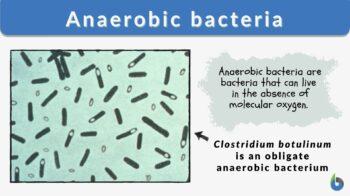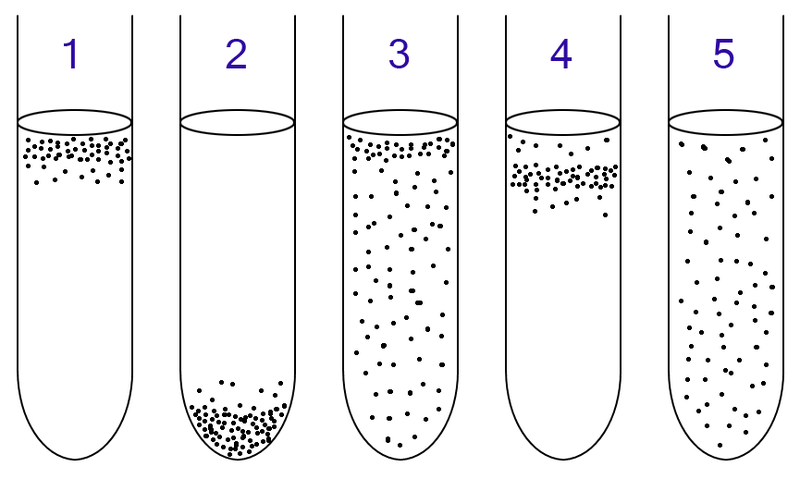
Anaerobic bacteria
n., singular: Anaerobic bacterium
[ˌænɛəˈrəʊbɪk bækˈtɪɹ.i.ə]
Definition: Bacteria capable of living in the absence of molecular oxygen
Table of Contents
Bacteria are classified according to the need for oxygen to survive and grow. For example, aerobic bacteria are bacteria that can only grow in an oxygen-rich environment. But what about anaerobic organisms, such as anaerobic bacteria? What are anaerobic bacteria? Let’s find out!
Anaerobic Bacteria Definition
Aerobic bacteria are bacteria that do not require oxygen. So anaerobic bacteria survive in areas that have low oxygen supply. In the human body, for instance, anaerobic bacteria can cause serious infections. They are the main cause of abscesses and tissue death or necrosis.
Anaerobic bacteria can produce enzymes and toxins that can destroy tissues and lead to the death of organs. The most abundant infections which are mainly developed by anaerobic bacteria are gangrene and tetanus. However, some antibiotics with anaerobic coverage can be used for the treatments.
Anaerobic bacteria may be gram-negative or gram-positive. Each type may cause a variety of diseases. Examples of some gram-negative anaerobic bacteria that cause diseases are:
- Bacteroides: Bacteroides are found in the colon of humans and genital of the female as normal flora. But they may be pathogenic and cause abdominal diseases, abscesses, aspiration pneumonia, and brain abscesses.
- Campylobacter: the main cause of acute gastroenteritis
- Fusobacterium: Not all groups are anaerobic. Fusobacterium necrophorum is the only anaerobic member. It mainly causes abscesses of the tonsillar, leading to the thrombosis of the jugular vein.
- Prevotella melaninogenica: Prevotella is a non-spore-forming gram-negative coccobacilli bacteria. They are mostly found in the oral cavities as opportunistic pathogens.
- Bilophila wadsworthia: Bilophila is a gram-negative bacteria. It releases B lactamase enzymes that resist penicillin. It can be isolated from gangrened tissues, pleural fluids, and pus from abscesses of the scrotal.
On other hand, some infectious diseases are caused by gram-positive anaerobes as the following :
- Clostridium: Clostridium is an anaerobic spore-forming rods. This group consists of three members, such as Clostridium difficile, Clostridium perfringens, and Clostridium septicum responsible for gas gangrene and other serious infections.
- Propionibacterium: they are found in the skin and mucosa as normal flora. Acne vulgaris is the most common disease generally caused by one member of this group called Propionibacterium acne.
- Lactobacillus: they colonize the gastrointestinal tract as being a normal flora. they are found in many foods. So, they can be restored by eating those foods. They are the least pathogenic gram-positive bacteria. However, it may cause an abdominal abscess in neonates.
- Peptostreptococcus anaerobius bacteria and finegoldia: they are also anaerobic bacteria examples.
- Parvimonas micra : it is found in cocci shape. It is mainly found on mucous membranes and the surface of the skin.
Anaerobic bacteria are bacteria capable of living in the absence of molecular oxygen. In general, these bacteria do not require oxygen for their growth and metabolism although some of them (referred to as facultative anaerobic bacteria) are capable of using oxygen when present and carry out aerobic respiration. Other bacteria (referred to as obligate anaerobic bacteria) can neither use oxygen nor convert the lethal superoxide formed in their cells due to the presence of oxygen. Synonym: anaerobes. Compare: aerobic bacteria
First Observation
The first detection of the anaerobic bacteria was between 1665 to 1683 by the royal society. Then two scientists followed the royal society — Robert Hooke and Antoni van Leeuwenhoek. As Robert Hooke imagined the first depiction of the microorganism and called it microfungus mucor. Then Antoni detected the microscopic bacteria by an experiment using a sealed and an open tube, he examined the content of both tubes under the microscope and detected anaerobic bacteria within the sealed tube as follows:
- Antoni brought two glass tubes and filled them with powder of crushed pepper.
- Antoni added some rainwater to both tubes.
- Antoni sealed one tube using the flame and left the other open.
- After several days, Antoni found animalcules that have a particular motion in the open tube as expected by Anotni. Those were aerobic bacteria.
- Antoni found animalcules in the sealed tube which were bigger than animalcules found in the open tube. Those were anaerobic bacteria.
In 1860, Pasteur managed to define anaerobic bacteria and discovered their anaerobic activity. Antoni defined anaerobic microbes as microbes that could grow without oxygen and referred to this type of growth as anaerobic growth. In addition, Pasteur was able to detect the role of bacteria in human infections with the help of Joubert. They managed to discover the first anaerobic bacteria called septic Vibrio, which is now known as Clostridium sepricum. Additionally, Pasteur was not only able to cultivate the bacteria, but he also described the symptoms of the disease caused by septic Vibrio. In 1913 Martinus Beijerinck confirmed Antoni’s imagination about anaerobic bacteria. Moreover, He detected and discovered the Clostridium butyricum.
Classification
Anaerobic bacteria can be classified according to the tolerance of oxygen to three types of anaerobic bacteria as follows:
- Facultative anaerobes: in biology, they are defined as bacteria that can grow either in the presence or absence of oxygen. In the presence of oxygen, they produce energy mainly by aerobic respiration. In the absence of oxygen, they generate energy by fermentation. E. coli facultative anaerobes are the main example of this type. Salmonella is another example; it is an anaerobic gram-negative rod.
- Obligate anaerobes: Obligate anaerobes are bacteria that cannot grow in the presence of oxygen. Oxygen is toxic for these bacteria. So, the main pathway by which they can produce energy is the fermentation pathway. When they are exposed to high concentrations of oxygen, they form endospores to survive in this hard condition. Obligate bacteria can be found in the body of humans as normal flora in mucous membranes. Peptostreptococcus, Clostridium, and actinomyces are examples of obligate anaerobes.
- Aerotolerant anaerobes: they can tolerate oxygen for a limited period of time ranging from 8 to 72 hours. But they are unable to grow in the presence of oxygen. The only pathway to produce energy is fermentation as an obligate type. Clostridium and Streptococcus anaerobic bacteria are the main examples of the aerotolerant type.

1- obligate aerobes grow on the top in direct contact with oxygen
2- obligate anaerobes grow at the bottom to avoid contact with oxygen
3- facultative anaerobes grow in the middle where they may or may not be in contact with oxygen
4- microaerophiles require lower concentrations of oxygen
5- aerotolerant spread in the tube as they are not affected by the concentration of oxygen
Image Credit: Wikimedia
Energy Metabolism
The first step in producing energy either in aerobic or anaerobic bacteria is carbohydrates catabolism. The main carbohydrate which is used to produce energy is glucose. Anaerobic bacteria produce energy by breaking down glucose by glycolysis to transform a six-carbon molecule ” glucose” into a three-carbon molecule “pyruvate”. During this transformation, energy is generated as 4 ATP molecules, 2 NADH, and 2 pyruvate molecules. After producing pyruvate molecules, the reaction can go further depending on the existence of oxygen.
If oxygen is available, pyruvate is oxidized into two-carbon acetyl by the pyruvate dehydrogenase enzyme. The two-carbon acetyl molecules interact with two molecules of the co-A enzyme to produce a product that later enters the Krebs cycle to generate a sufficient amount of energy. On the other hand, If oxygen is not available, the shift from aerobic respiration to fermentation process occurs.
Fermentation
Fermentation is the final step of glycolysis in case of the absence of oxygen. In glycolysis, the final product produced is pyruvate. In anaerobic conditions, the fermentation process begins and the Krebs cycle does not occur.
Why the Krebs cycle doesn’t occur during fermentation? Krebs cycle needs a NAD carrier to run. The absence of oxygen leads to the absence of NAD carriers which carry electrons. So the goal of the fermentation process is to form NAD from NADH. Therefore, many reactions are done during the fermentation process to form the NAD carrier from NADH. Only two molecules of ATP are generated from the catabolism of one sugar molecule during fermentation.
During the lactic acid fermentation, lactate molecules that are produced at the last step are protonated to form the lactic acid. In this process, the NADH drops off its electrons directly to the pyruvate molecules to convert them to lactate molecules. This process can be done either in bacteria as during the production of yogurt or in the human body especially in cells that do not have mitochondria such as red blood cells.
Not only do the cells which have no mitochondria use the fermentation process, But muscles also use that pathway when they get exhausted and lack sufficient oxygen supply to perform aerobic respiration. Consequently, lactic acid is produced in muscles causing cramps.
Alcohol fermentation is another type of fermentation. Unlike lactic acid fermentation in which the NADH donates the electron directly to the pyruvate. In alcohol fermentation, The NADH drops off the electron on the derivative of lactic acid. This process has main two steps known as NAD regeneration steps.
- Two (2) pyruvate molecules are converted into 2 acetaldehyde molecules and CO2 is produced as a by-product.
- Acetaldehyde molecules are converted into 2 ethanol molecules. So NADH drops off its electron to acetaldehyde and converted it to ethanol. Then two NADH are reduced to NAD.
Culturing Anaerobes
The culture of anaerobic bacteria is very difficult and expensive to perform. As it is necessary to exclude oxygen from the environment. A vessel filled is one of the culture methods used with non-sensitive organisms. Another culture method is the specimens. As the anaerobic bacteria are a part of the normal flora of the human body, another culture method is to get swabs from the body, however, it is the least used method. The best sites to collect the specimen are CNS, Abscesses, Dental abscesses, and Abdominal abscesses.
Multicellularity
There are no multicellular anaerobic bacteria to date. But we have few anaerobes that are multicellular. In 2010, some anaerobe marine multicellular anaerobe animals were found in the Mediterranean sea where water is hypersaline. They do not produce energy by aerobic respiration since they have no mitochondria. Therefore, they produce energy depending on hydrogen instead of oxygen.
Try to answer the quiz below to check what you have learned so far about anaerobic bacteria.
References
- Anaerobic Bacteria – Bacterial Types, Taxonomy and Examples. MicroscopeMaster. (n.d.). Retrieved March 25, 2022, from https://www.microscopemaster.com/anaerobes.html
- Bush, L. M., & Vazquez-Pertejo, M. T. (2022, March 22). Overview of anaerobic bacteria – infectious diseases. MSD Manual, Professional Edition. Retrieved March 25, 2022, from https://www.msdmanuals.com/professional/infectious-diseases/anaerobic-bacteria/overview-of-anaerobic-bacteria
- Cell processes: Fermentation. Cell Processes: Fermentation | Texas, Gateway. (n.d.). Retrieved March 25, 2022, from https://www.texasgateway.org/resource/cell-processes-fermentation
- Sebald, M. & Hauser, D. (1995). Pasteur, oxygen and the anaerobes revisited. Anaerobe. Retrieved March 25, 2022, from https://pubmed.ncbi.nlm.nih.gov/16887501/
- Encyclopædia Britannica, inc. (n.d.). Fermentation. Encyclopædia Britannica. Retrieved March 25, 2022, from https://www.britannica.com/science/fermentation
- Freelance clinical Microbiologist Follow. (n.d.). Anaerobic culture methods. SlideShare a Scribd company. Retrieved March 25, 2022, from https://www.slideshare.net/doctorrao/anaerobic-culture-methods
- Gram-negative facultatively anaerobic rods. Gram-Negative Facultatively Anaerobic Rods – an overview | ScienceDirect Topics. (n.d.). Retrieved March 25, 2022, from https://www.sciencedirect.com/topics/immunology-and-microbiology/gram-negative-facultatively-anaerobic-rods
- Gest, H. (2004). The discovery of microorganisms by Robert Hooke and Antoni Van Leeuwenhoek, fellows of the royal society. Notes and records of the Royal Society of London. Retrieved March 25, 2022, from https://pubmed.ncbi.nlm.nih.gov/15209075/
- Noor, A. (2021, August 22). Anaerobic infections. StatPearls [Internet]. Retrieved March 25, 2022, from https://www.ncbi.nlm.nih.gov/books/NBK482349/
- Parker, N., Schneegurt, M., Tu, A.-H. T., Lister, P., & Forster, B. M. (2016, November 1). Catabolism of carbohydrates. Microbiology. Retrieved March 25, 2022, from https://opentextbc.ca/microbiologyopenstax/chapter/catabolism-of-carbohydrates/
- U.S. National Library of Medicine. (n.d.). Anaerobic: Medlineplus medical encyclopedia. MedlinePlus. Retrieved March 25, 2022, from https://medlineplus.gov/ency/article/002230.htm
- Yu, Q., Sun, L., Xu, Z., Fan, L., & Du, Y. (2021, April 17). Severe pneumonia caused by Parvimonas Micra: A case report – BMC infectious diseases. BioMed Central. Retrieved March 25, 2022, from https://bmcinfectdis.biomedcentral.com/articles/10.1186/s12879-021-06058-y
- Zyga, L. (2010, April 7). Scientists discover first multicellular life that doesn’t need oxygen. Phys.org. Retrieved March 25, 2022, from https://phys.org/news/2010-04-scientists-multicellular-life-doesnt-oxygen.html
©BiologyOnline.com. Content provided and moderated by Biology Online Editors.




